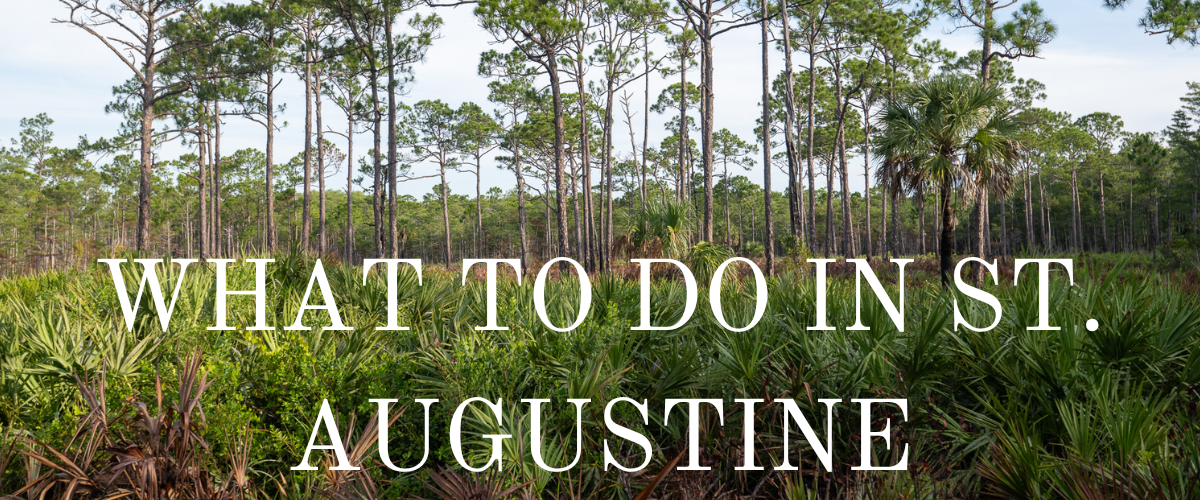
What to Do in St. Augustine
Nestled along Florida’s northeast coast, historic St. Augustine has quickly become a quintessential vacation hotspot. In part because of all the amazing things to do in town - with beaches, restaurants, music, and a rich history at your fingertips, the opportunities are endless. We encourage you to get outside into wild Florida and experience all there is to offer. Let this serve as your local’s guide to some of the best activities in town, but feel free to explore on your own.
Nature

Nature-based activities are everywhere in St. Augustine, with a number of sandy beaches, nature trails, and state parks, there is something for everyone to enjoy:
- Anastasia State Park - A beautiful state park and campground on the coast of St. Augustine Beach, which happens to be where the St. Augustine Amphitheatre is located as well. You'll have access to rent standup paddle boards and kayaks in the intracoastal, giving you a chance to see lots of wildlife. A family-friendly place with nature trails and entry to the beach, Anastasia State Park is definitely a great spot to check out. Local tip: The Ancient Dunes Trail located within the park is one of the best trails to hike.
- Moses Creek Conservation Area - An undeveloped tidal creek located in St. Johns County with 8 natural communities: scrub, sandhill, upland mixed forest, freshwater tidal swamp, mesic flatwood, dome swamp, depression marsh, and estuarine tidal marsh. With such a diverse native landscape, Moses Creek offers one of the best spots to explore wild Florida in its natural state. Visitors can enjoy all sorts of activities ranging from hiking and horseback riding, to fishing and camping.
- Boat Tours - There are several local businesses in St. Augustine that provide boat tours through the intracoastal waterway. Enjoy the opportunity to explore local waters, see dolphins and other wildlife, and maybe even go on a sunset cruise.
- St. Augustine Alligator Farm Zoological Park - Opening in the late 19th century, the Alligator Farm has been a visitor staple, especially for those traveling with kids. It functions as modern zoo attraction with reptile exhibits, educational shows, and ziplining.
- The Beach - For a more relaxing day outdoors, make sure to visit one of the many beaches in town. With St. Augustine Beach, Vilano Beach, or even the Matanzas Inlet, there is a vast coast to explore different kinds of beaches and areas within the town. Make sure to bring a towel and some sunscreen because the Florida heat is no joke!
History

As the oldest city in America, one can imagine that St. Augustine is rich in history and cultural significance. Visitors have lots of options to choose from when it comes to learning more about the city.
- Climb the Lighthouse - With a history dating back to 1589, the St. Augustine Lighthouse and Maritime Museum is an impressive piece of history in town. From being the first wooden watch tower in the 1500s to its present-day construction, the lighthouse still serves as an aid to navigation for boaters. Spend the day climbing 219 steps to the top where you’ll see beautiful views of the city, followed by exploring the grounds and maritime museum.
- Walk down St. George Street - Home to the colonial quarters, St. George Street is a bustling part of the town where tourists can go to experience the rich history, walk along the cobblestone streets, and stop into local shops and restaurants along the way.
- Tour Flagler College - Built more than 130 years ago by Henry Flagler, industrial tycoon and founder of Standard Oil, the college was originally constructed as the Hotel Ponce De Leon, the first of many luxury hotels built along the coast of Florida. This monument of a building was constructed with Spanish Renaissance architecture and is now considered a National Historic Landmark where Flagler College students live and attend class. The college is open for tours, where visitors can explore the college, and see inside some of the great architecture, including the Tiffany-stained glass windows in the dining hall.
- Fort Mose - Each year, St. Johns County Cultural Events holds the Fort Mose Jazz and Blues Series, a musical festival in one of the richest historical areas of our town. When it’s not acting as a music venue, the park offers a unique opportunity to explore the area that served as a sanctuary and home for fugitive slaves seeking freedom under English tyranny. Established in 1738, Fort Mose holds a significant place in American History as the first legally sanctioned African settlement in what would become the United States.
- Fountain of Youth - Originally home to the Native Timucua Indians, Seloy Village, Spanish explorer Don Pedro Menendez de Aviles traveled here to claim the land and establish the city of St. Augustine on the coast. The Fountain of Youth Archaeological Park is a 15-acre historical waterfront attraction where visitors can explore the grounds and various exhibits within the park. Local tip: There are peacocks that live within the grounds which gives guests a chance for prime bird watching.
- Ghost Tour/Trolly Ride - With all the history in this town, there's bound to be some kind of ghost story to share. If that’s your thing, you can book the famous Ghosts and Gravestone Tour on one of the Old Town Trolleys, which will take you on a nighttime trip to spooky attractions. If you’d rather go without the ghosts, you can also book a daytime Trolly ride that goes throughout the city, where you’ll learn fun stories and interesting facts about St. Augustine.
- Explore Castillo de San Marcos - This major coquina structure located in downtown St. Augustine is the oldest masonry fortification in the United States and was used by the Spanish to defend both Florida and the Atlantic Trade Route over 450 years ago.
